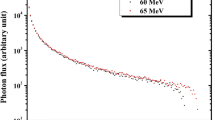Abstract
The capability of prompt gamma-ray activation analysis (PGAA) for neutron fluence dosimetry by means of transmutation detectors is reported. The metallic foils of Ni, Au, Cu and Nb and the small piece of Ge crystal, which were irradiated at the LVR-15 reactor at Řež for several days, were selected for analysis by PGAA technique. Concentrations of transmuted stable nuclides in these foils were measured using the PGAA facility installed at the research reactor FRM II in Garching.





Similar content being viewed by others
References
Viererbl L, Lahodová Z, Klupák V, Sus F, Kučera J, K\(\mathring{{\rm u}}\)s P, Marek M (2011) Transmutation detectors. Nucl Instum Meth A 632:109–111
Canella L, Kudějová P, Schulze R, Türler A, Jolie J (2011) Characterisation and optimisation of the new prompt gamma-ray activation analysis (PGAA) facility at FRMII. Nucl Instrum Meth A 636:108–113
National Nuclear Data Center database: http://www.nndc.bnl.gov/capgam. Accessed 20 Nov 2013
Basu SK, Mukherjee G, Sonzogni AA (2010) Nuclear Data Sheets 111: 2555 http://www.nndc.bnl.gov/ensdf/. Accessed 20 Nov 2013
Bečvář F (1998) Simulation of \(\gamma \) cascades in complex nuclei with emphasis on assessment of uncertainties of cascade-related quantities. Nucl Instrum Meth A417:434–449
Acknowledgments
This work has been supported by the Technology Agency of the Czech Republic (projects TA01010237). This work was performed within the scope of research project FR-Tl1/397 of the Ministry of Industry and Trade. Some of the authors (I.T., L.V., Z.L. and V.K.) are very appreciative to the TU Munich for the hospitality during the PGAA experiments in Garching. The authors are grateful to J. Jolie from University of Cologne for lending \(^{198}\)HgS target material.
Author information
Authors and Affiliations
Corresponding author
Appendix
Appendix
The production of the mercury isotopes, \(^{198}\)Hg, \(^{199}\)Hg and \(^{200}\)Hg, in the process if irradiation of gold, \(^{197}\)Au is described by series of differential equations,
where \(N_a(t)\), \(N_b(t)\), \(N_c(t)\), \(N_d(t)\), \(N_e(t)\) and \( N_f(t)\) are quantity of \(^{197}\)Au, \(^{198}\)Au, \(^{199}\)Au, \(^{198}\)Hg, \(^{199}\)Hg and \(^{200}\)Hg nuclei in time \(t\) , respectively, \(\lambda _A\), \(\lambda _B\), \(\lambda _D\) and \(\lambda _E\) are the reaction rates for \(^{197}\)Au,\(^{198}\)Au,\(^{198}\)Hg and \(^{199}\)Hg(n,\(\gamma \)) reactions, respectively, and \(\lambda _b\) and \(\lambda _c\) are decay constants for \(\beta ^-\)-decay of \(^{198}\)Au and \(^{199}\)Au, respectively. Solving these equations one will obtain the general solutions for quantity of nuclei during irradiation
where we have used general notation \(\lambda _{ij}=\lambda _i-\lambda _j\) and \(N_a^0\) is number of gold nuclei before irradiation. In time of analysis \(t_m\) long time after the stop of irradiation \(t_2\), i.e. \((t_m-t_2) \gg 1/\lambda _b\) and \((t_m-t_2) \gg 1/\lambda _c\), number of \(^{197}\)Au, \(^{198}\)Hg, \(^{199}\)Hg and \(^{200}\)Hg nuclides can be expressed as
Rights and permissions
About this article
Cite this article
Tomandl, I., Viererbl, L., Kudějová, P. et al. Determination of trace concentrations of transmuted stable nuclides in TMD detectors using PGAA. J Radioanal Nucl Chem 300, 1141–1149 (2014). https://doi.org/10.1007/s10967-014-3090-5
Received:
Published:
Issue Date:
DOI: https://doi.org/10.1007/s10967-014-3090-5




